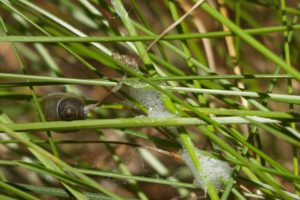Written by Nancy Nabak, Communication Coordinator
 Now that we’re fully into summer, I urge you to slow down with nature and observe it at a “Sunday Driver’s” pace, or in natural terms, a snail’s pace.
Now that we’re fully into summer, I urge you to slow down with nature and observe it at a “Sunday Driver’s” pace, or in natural terms, a snail’s pace.
Instead of hurrying to list all the bird species you can find, go for a walk or hike with the idea of listening for food-begging sounds from nestlings, or observe which plants are flowering right now. Then take a closer look and notice how busy they are with pollinators.
While doing that, see if you notice bubbles on the leaves or stems. That’s the product of the spittlebug. Spittlebugs are so cool and so underrated. This tiny insect sucks up watery sap from the plant, lots and lots of sap, so it creates lots of urine – like 150 to 280 times its body mass every day. (Wow!) The urine comes out as the bubbly foam. The bubbles form a safe cocoon for the insect to grow and protect it from predators. Hang out and watch the bubbles for a while, you might see the tiny nymph moving around inside.
Take advantage of the warm night air and be a kid again – go look for lightning bugs! These bioluminescent wonders are a free visual concert, but like so many other insects they’re facing serious threats. Next to habitat loss, light pollution is their big enemy. Lightning bugs depend on their ability to light up and be seen for courtship and attracting a mate, but too much artificial light is interfering with this. Find a nice lot away from city lights that has nice green vegetation, they like moisture. Enjoy this precious moment in awe. Savor what you find.
Observe moths pollinating at night. Nocturnal flowers with pale or white flowers and a strong fragrance attract moths. Just follow your nose to your next dusk-discovery.
Challenge yourself to identify five evening sounds and once you get them, go for five more.
Since we’re observing at a snail’s pace, why not look for snails? Did you know that Wisconsin has 100 land snail species? You can find them on all kinds of surfaces because they know how to get around, it just takes a while. Secrete slime. Crawl. Secrete slime. Crawl. You get the picture.
Snail slime, a natural product to be sure, but it’s no longer for locomotion only. Some cosmetic companies are now using it as an exfoliant that removes dead skin cells and stimulates cell renewal. Cool nature nerd fact – snail slime’s exfoliating properties are attributed to the natural collagen, elastin and glycolic acid found in it.
So, let’s not “busy” our summer away. Let’s not be in a rush to list birds, but forget to admire and appreciate them. Slow down. Relax on your back porch and just observe what nature is doing around you. In summary, see the snail, be the snail.
Photo of spittle bug in spittle and snail by Nancy Nabak
